 Category: Virginia Wineries
Category: Virginia Wineries
Outsmarting Birds and other Vineyard Predators
The grapes at DuCard Vineyards are starting to ripen nicely, which means that pretty much every creature that walks, flies or crawls is out to feast on them.
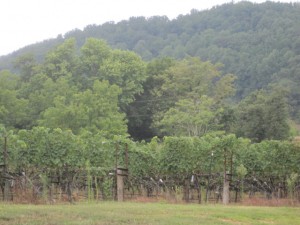
DuCard Vineyards in mid-August. The Cab Franc grapes are looking beautiful. Should be another great vintage for DuCard
There’s an old saying that goes something like this: when the deer begin eating the grapes, the Brix (a measure of the sugar level) is 20, when the birds begin feeding, it’s 22, and when the bees go after grapes, it’s time to harvest. (If anyone has a more accurate take on that little bit of country wisdom, please post a comment!)
That aphorism probably ascribes a level of precision to nature that can’t be verified with scientific instruments, but it does give you an idea of what the grape farmer is up against. After a growing season in which the vines are threatened by any one of a dozen pests or diseases, not to mention the vagaries of weather, Mother Nature presents a whole new set of challenges just as the grapes are reaching perfection.
Saturday’s vineyard management class at DuCard focused on a number of these problems, and some of the tried and true solutions that have been used by viticulturists for years. Some are high tech, like the box that transmits sounds of birds in distress throughout the vineyard, and others are decidedly low-tech: balloons and CDs hanging from trellises in spots where they’ll catch a bit of sunlight. All three seem to work pretty well.
Birds apparently have some early warning systems. They understand the vineyard is supposed to look a certain way, and when they see something out of the ordinary, they look for safer pastures, so to speak. The CDs catch a glint of sunlight, and are visible to the birds as they approach, sending off the signal
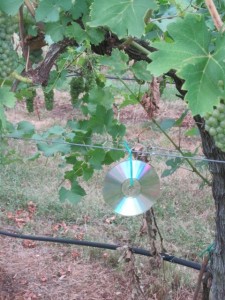
Any old song will do: Not sure if it matters which CDs we hang from the vines, they all seem to scare the birds.
that something is not quite right here, so move on, and be quick about it. The balloons accomplish the same thing. In other vineyards, I’ve seen foil streamers flying in the breeze, which has the same effect.
And the deer will be coming soon as well. DuCard is located in the midst of open country, some of the most beautiful country you’ll ever see, and so it’s home to more deer than any of us can count. The electric fence is going up this week, and between the fence, the balloons and the CDs, Scott thinks he has “about a 95 percent solution,” which I think is a nice compromise with nature.
While walking through the vineyard Saturday, I tasted a few Cab Franc and Viognier grapes, and was impressed by the sweetness. We’re getting toward the end of the period of veraison, the time in which the berries stop growing in size and begin ripening, turning color in the process. The Cab Franc gapes, for example, were about 80 percent there (by my own seat-of-the-pants measurement), with most of the grapes blue-black in color, and only a few still greenish. They’re looking magnificent, and the growing sugar level was evident on my tongue when I tasted the grapes.
As we move toward harvest, the sugar will continue to increase and acidity will drop. The seeds inside the grape will turn color from their current green to more of a brown, and will lose their bitterness. Soon, Scott Elliff, DuCard’s owner, and Julien Durantie, his vineyard manager, will begin testing the grapes regularly, taking advantage of both technology (checking the Brix with a refractometer), and the knowledge that comes from years of working in vineyards (looking at the seeds, chewing the skin to get an idea of the tannins, etc.)
The day of the harvest can’t be predicted this far in advance, and of course each of the four varieties of grapes Scott grows will ripen at different times. But at some point for each, everything will come together, and Scott will make the judgment that it’s time to get the grapes off the vine and onto the crush pad.
And then we can start dreaming about the wine.
WBC11 – A Conference for Wine Bloggers
I’ve been meaning for a week now to write something about the Wine Bloggers Conference (WBC11) that was held in Charlottesville July 22-24. It was a well-planned, well-executed conference, but what I think was most important about it for the purpose of this blog is the way it showcased Virginia’s wine industry. Some 325 bloggers from around the country attended, and they were all exposed in a variety of ways to Virginia wine.
While I was gathering my thoughts, I had occasion to read two really terrific posts from Frank Morgan on his blog, "Drink What You Like." I started to respond to the post, and my piece turned out to be too long for a comment – probably too long for a blog post, for that matter – so I decided to submit a trimmed-back version to his blog and run the extended piece here. If you haven’t yet seen Drink What You Like, trust me, it’s well worth a visit.
What’s great about these two posts (A View from the Punt, I and II) is the perspective it provides from “the other side of the bottle” – the views of those who were pouring their wines at this conference. I had actually been wondering what the winemakers, vineyard managers, marketing directors and others who poured during the conference thought about the event and about the bloggers. They pour (sorry for the pun) their lives into their wines, then pour the wines for people who sniff and swirl it for a few moments before rendering judgments that can be generous in their praise or critical to the point of being mean-spirited. Continue Reading–>
The Agony of Dropping Fruit
This is only a guess, albeit a somewhat educated guess, but I suspect every vineyard worker has the same uneasy, guilty feeling the first time he drops fruit from a vine.
By dropping fruit, I mean walking through the vineyard, from one vine to the next, and cutting off perfectly good clusters of grapes and letting them fall to the ground. It seems wasteful, and when you see a cluster of nearly perfect grapes lying on the ground next to your feet, you feel like a butcher. But you have to remain focused and keep your eye on the prize.
“Think about the wine,” said Julien Durantie, the vineyard manager at DuCard Vineyards. Ah, yes, the wine. Don’t worry about the grapes on the ground that will soon rot and return to the soil to nurture future crops. Think ahead a year or more to the wine that will be made from the fruit that remains.
The idea behind dropping fruit is simple: the vine has only so much energy, and by reducing the number of clusters, you end up with a more concentrated juice and much better, much more intense wine. In a sense, this is a continuation of the process we’ve been engaged in throughout the growing season. Early on, we thinned out the shoots, leaving behind a smaller number of shoots that we hoped would produce high-quality grapes. As we moved through the season, pulling leaves to open up the canopy, we continued to remove suckers, laterals, and extra shoots that would deprive the vine of its vigor.
Removing suckers and thinning shoots was one thing. Clipping off beautiful clusters of berries that were turning into wine grapes, was much harder. I tried to keep my mind focused on the wine.
As was the case in many classes before, I found myself nearly paralyzed at the start, not quite remembering what I had been told, and staring at the vine, afraid to make the first cut. And so, I spent time separating out vines that had become tangled, pulling some laterals (which look like a small, separate leaf system), and considering whether to cut this clump or the next one. And finally, as always, I called Scott Eliff, the vineyard’s owner, or Julien, and begged for help.
We were working just at the onset of veraison, the time in which the berries change color. Here and there, we spotted a few cab franc grapes turning purple, but the vines we actually worked on were Viognier, Virginia’s signature white grape. (Actually, while the Virginia Wine Board has declared Viognier to be the Commonwealth’s Signature Grape, I prefer to think of it as the signature white. Cab Franc and Petit Verdot are my choices for reds.
In any event, a little bit of my heart lay on the ground with each cluster of grapes. And I was only the hired (well, volunteer) help. I can’t imagine how agonizing it is for the owner of the vineyard to drop fruit, knowing he or she is reducing the vineyard’s yield significantly with each clip of the pruning shears.
Fortunately, this is one kind of heartache that can be cured by opening and tasting a bottle of wine that has benefitted from the “Green Harvest” of dropping fruit. Wine is often said to be made in the vineyard, and the best is made by vineyards like DuCard that are willing to sacrifice quantity for quality.
Canopy Management, Part II
Here’s some pictures from the weekend class at DuCard Vineyard, thanks to classmate Margaret Frazier, who I have no doubt will one day soon be producing very high quality Virginia wines.
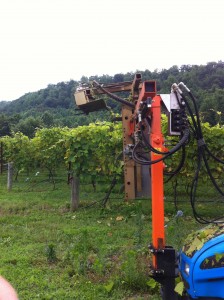
This is the hedger used to trim the tops of the vines in the lyre trellis. It's a bit hard to tell, but the arm of the hedger has whirling blades on both sides, which cuts one arm of the vines.
Canopy Management (And Other People’s Vines)
There's something quite liberating about working on someone else's vines.
Through a class at Piedmont Virginia Community College, we've worked on vines at DuCard Vineyeards now on five separate occasions, starting with dormant winter pruning in late winter and moving on through various stages of the vine's annual growth. On each occassion, I started off, as did many of my classmates, staring at a vine, certain that I was about to ruin it, if not forever, than surely for the season, perhaps costing DuCard a small but meaningful share of its harvest.
Most often, I wanted for DuCard's ever-patient owner, Scot Elliff, or his equally patient vineyard manager, Julien Durantie, to show me just one more time how to do whatever it was that we were expected to do that day. At some point, I would begin working on my own, tentatively at first, but with increasing confidence until at some point, I thought myself almost ready to work without supervision. Continue Reading–>
Grow Tubes Reconsidered
Those of you who have been following this blog know that I recently offered some unkind words about grow tubes, which many vineyards use to nurse along young vines. My criticism was based partly on research and partly on personal experience.
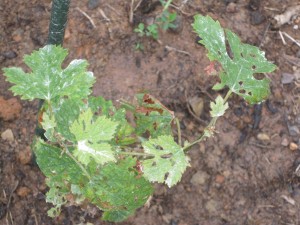
The Nelson vineyard vines, (do seven vines make a vineyard?) after removal of the tubes, leave a lot to be desired.
As I recounted, we had been told in one vineyard management class to use grow tubes, and then, in another, to get them off the vines post-haste. We had two points of reference.
First, our Fairfax vines, which were planted and nurtured without benefit of grow tubes, are doing spectacularly well. It’s possible, of course, that we’re just kidding ourselves, and the growth we’re seeing is the result of overly vigorous vines. While vigor is no
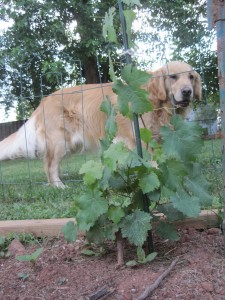
The Fairfax vines (all seven of them) seem to be flourishing, perhaps because Phoenix, the Vineyard Dog, stands guard over them.
doubt welcomed by farmers raising soy or corn, overly aggressive vines produce low-quality fruit. We want the vigor to go to the grapes, not the vines.
Be that as it may, the Fairfax vines appear strong and healthy. By contrast, the vines on our Nelson County property, which were planted with the protective shelter of grow tubes, seem, well, frail. They have holes in the leaves. Lots of holes. And scrawny, brown-looking leaves. Not what we had hoped for at all.
We wondered if the grow tubes were the problem. One of our friends who manages a large vineyard, urged us to take the tubes off, warning that, in this heat, all we were doing was baking the vines. We did some investigating on our own, and much of the research we looked at suggested that the only reason for using grow tubes is to facilitate the use of herbicides – the tubes protect the vine while Roundup or something like that clears vegetation out of the rows of vines.
So, we swore of grow tubes, and I wrote an angry rant about them. I haven’t changed my mind, but in fairness, I have to say that it appears that almost everyone else in this business loves grow tubes. Continue Reading–>
A Trio of Virginia Wineries
I'm planning to add some reviews of the wineries I like, but that will take a bit more time than I have today. So, for now, I'm just going to offer a list of three wineries in the Monticello AVA that I am particularly fond of. And there is a theme here: these are the three wineries who came together to make a wine they named (appropriately enough) "3."
Emily Pelton of Veritas Vineyards stands behind bottles of "3" wine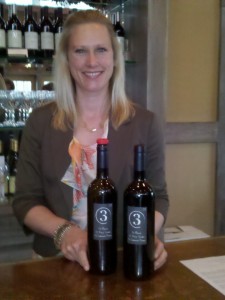
Each of the three contributed one of the varietals to the blend. Pollak Vineyards provided the Petit Verdot, Veritas Vineyard and Winery supplied the Cab Franc, and King Family Vineyards contributed the Merlot grapes. In theory, they planned to blend one third each of the grapes, but in practice, I think they realized that a blend required some judgment, and would likely end up being something other than one-third each. When blending wines, as I learned from King Family winemaker Matthieu Finot, you spend a lot of time experimenting and tasting. In this particular blend, I'm guessing that the Petit Verdot was very powerful, and they may have decided to use less of it and more of either of the other two grapes.
No matter. The wine was fabulous, and since they only made 150 cases, it sold out quickly. Each customer at Veritas was limited to three bottles at $33.33 each — yes, they carried the 3 theme pretty far — and I personally think this one will age quite well. So my three bottles are stored in my EuroCave wine celler, waiting for that perfect moment in the near future when they will achieve perfection.
A Vineyard Management class at DuCard Vineyards
Saturday's vineyard management class was the second of four at DuCard Vineyards, in Etlan, Virginia. We've been working with a section of Norton vines, and we'll be seeing them through until the harvest. Lots of work done is while we're not there (spraying, among other things), but we're doing much (well, some) of the essential work on the vines.
Scott Elliff, the vineyard's owner, has been migrating his vineyard from a Geneva Double Curtain trellising system to a modified Lyre system, so in our first class, we worked on pruning vines to facilitate that transition. Both GDC and Lyre are divided canopy systems in which the trunk of the vine is planted in the middle of two sets of trellis wires about four feet apart. With GDC, the vines grow downward, like a waterfall on each side of the row. With Lyre, they run up. Continue Reading–>

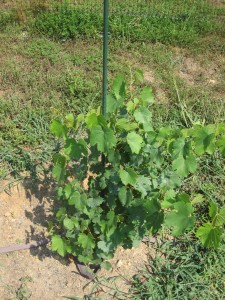
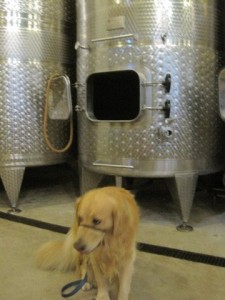
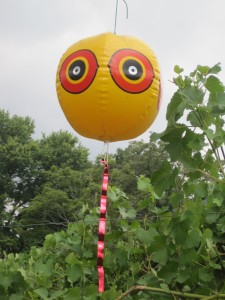
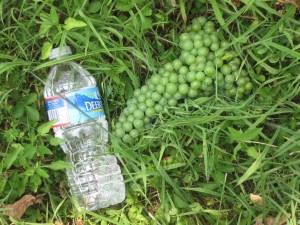
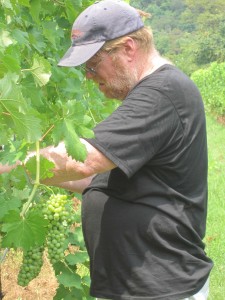
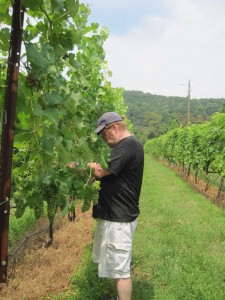
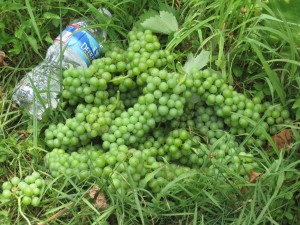
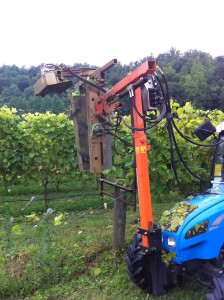
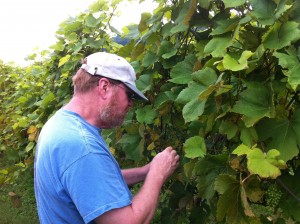
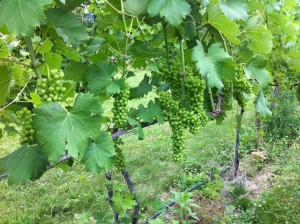
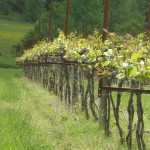
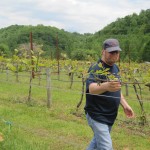
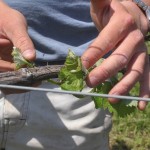
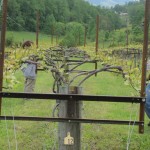
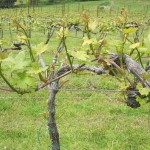
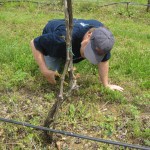


Recent Comments